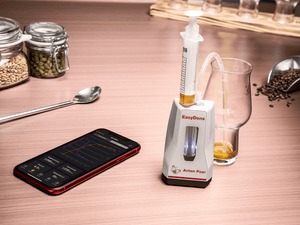Sauvignon Blanc Fermentation Tracking with EasyDens
![]()
Making wine is a mix of tradition, expertise and art.
Sauvignon Blanc is one of the most popular and well-known white wines, originating in the Bordeaux region of France. It tastes fruity-dry and is made from green grapes. Nowadays, it is widely cultivated all over the world.
HARVEST
The process starts in the vineyard. The timing of the grape harvest determines the quality of the final product. In order to collect the grapes at the optimum sweetness (usually between 23 °Brix and 24.5 °Brix), it is crucial to regularly monitor the sugar content. During ripening, first control measurements are taken with EasyDens to determine the sugar content. This parameter is very important because the more sugar your grapes contain, the more alcohol will be produced through fermentation.
![]()
DESTEMMING, CRUSHING & CLARIFICATION
Once the grapes are ready to be harvested, the procedure must be done carefully and efficiently. Since the grapes are harvested with their stems, they need to be destemmed in order to avoid bitter and undesirable flavors in the must. Then the grapes are crushed to mash (mixture of juice and skin). Quick quality checks of the must weight with EasyDens give information about the performance of the raw material.
The skin of the grapes is allowed to remain in the must for a few hours at low temperatures. This enriches the must with the aromas contained in the skins. However, this process needs to be carefully monitored, to protect the must from the bitter compounds in the skin. After the enrichment, the wine undergoes a clarification to remove remaining particles. At this point in the production process, the original gravity (specific gravity before fermentation) is measured. This measurement is necessary to determine the alcohol content at the end.
Now we come to the key step in wine production:
FERMENTATION
Sauvignon Blanc is usually fermented in a stainless-steel tank for about 12 days. To retain the fruitiness of the grapes the fermentation is performed at low temperatures (10 °C to 15 °C). By adding yeast and yeast nutrient to the must, sugar is converted to alcohol and carbon dioxide (CO2). For the winemaker it is necessary to control the temperature and rate of fermentation. Sauvignon Blanc needs to be slowly fermented at a cool temperature.
Making daily measurements during fermentation with EasyDens, the Wine Meister mobile app automatically plots a fermentation curve over time in which the yeast performance can be checked. By the trend of the curve the winemaker recognizes problems with the fermentation and can react quickly to ensure the quality of the wine. Additionally, with the knowledge of the original gravity and the measurements of final gravity (specific gravity during/after fermentation) Wine Meister calculates the est. % ABV of your wine automatically. Simple and quick - all in one batch.
When the wine reaches its desired alcohol content, between 11 – 13.5 % v/v the fermentation is stopped.
![]()
CLARIFICATION, BOTTELING & AGING
Yeast and other particles are removed via clarification and the Sauvignon Blanc is ready to be bottled and aged for at least 18 months.




